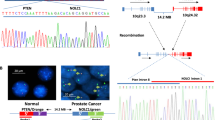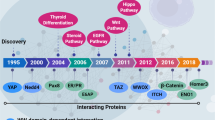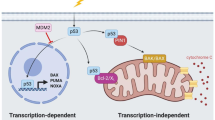Abstract
Several genes that contain the PR (PRDI-BF1 and RIZ) domain have been linked with human cancers. We describe here a new PR-domain-containing gene designated as PRDM5 (PFM2). A PRDM5 cDNA was isolated based on its homology to the PR domain of RIZ1 (PRDM2). The gene encodes an open reading frame of 630 amino acids and contains a PR domain in the NH-terminal region followed by 16 zinc finger motifs. Radiation hybrid analysis mapped PRDM5 to human chromosome 4q26, a region thought to harbor tumor suppressor genes for breast, ovarian, liver, lung, colon, and other cancers. The gene has a CpG island promoter and is silenced in human breast, ovarian, and liver cancers. A recombinant adenovirus expressing PRDM5 caused G2/M arrest and apoptosis upon infection of tumor cells. These results suggest that inactivation of PRDM5 may play a role in carcinogenesis.
This is a preview of subscription content, access via your institution
Access options
Subscribe to this journal
Receive 50 print issues and online access
$259.00 per year
only $5.18 per issue
Buy this article
- Purchase on Springer Link
- Instant access to full article PDF
Prices may be subject to local taxes which are calculated during checkout






Similar content being viewed by others
References
Arribas R, Risques RA, Gonzalez-Garcia I, Masramon L, Aiza G, Ribas M, Capella G and Peinado MA . (1999). Lab. Invest., 79, 111–122.
Bird AP . (1987). Trends Genet., 3, 342–347.
Buyse IM, Shao G and Huang S . (1995). Proc. Natl. Acad. Sci. USA, 92, 4467–4471.
Cardoso C, Timsit S, Villard L, Khrestchatisky M, Fontes M and Colleaux L . (1998). Hum. Mol. Genet., 7, 679–684.
Chittka A and Chao MV . (1999). Proc. Natl. Acad. Sci. USA, 96, 10705–10710.
Chou YH, Chung KC, Jeng LB, Chen TC and Liaw YF . (1998). Cancer Lett., 123, 1–6.
Clark SJ, Harrison J, Paul CL and Frommer M . (1994). Nucleic Acids Res., 22, 2990–2997.
Cui X, De Vivo I, Slany R, Miyamoto A, Firestein R and Cleary ML . (1998). Nat. Genet., 18, 331–337.
Du Y, Carling T, Fang W, Piao Z, Sheu JC and Huang S . (2001). Cancer Res., 22, 8094–8099.
Fang W, Piao Z, Simon D, Sheu J-C and Huang S . (2000). Genes Chromosomes Cancer, 28, 269–275.
Fang W, Piao Z, Simon D, Sheu J-C, Perucho M and Huang S . (2001). Br. J. Cancer, 84, 743–747.
Fears S, Mathieu C, Zeleznik-Le N, Huang S, Rowley JD and Nucifora G . (1996). Proc. Natl. Acad. Sci. USA, 93, 1642–1647.
Frommer M, McDonald LE, Millar DS, Collis CM, Watt F, Grigg GW, Molloy PL and Paul CL . (1992). Proc. Natl. Acad. Sci. USA, 89, 1827–1831.
Gardiner-Garden M and Frommer M . (1987). J. Mol. Biol., 196, 261–282.
He L, Yu JX, Liu L, Buyse IM, Wang M-S, Yang Q-C, Nakagawara A, Brodeur GM, Shi YE and Huang S . (1998). Cancer Res., 58, 4238–4244.
Heon E, Sheth BP, Kalenak JW, Sunden SL, Streb LM, Taylor CM, Alward WL, Sheffield VC and Stone EM . (1995). Hum. Mol. Genet., 4, 1435–1439.
Herman JG, Graff JR, Myohanen S, Nelkin BD and Baylin SB . (1996). Proc. Natl. Acad. Sci. USA, 93, 9821–9826.
Huang S . (1994). Cell, 78, 9.
Huang S . (2002). Nat. Rev. Cancer, 2, 469–476.
Huang S, Shao G and Liu L . (1998). J. Biol. Chem., 273, 15933–15940.
Jiang G-L and Huang S . (2000). Histol. Histopathol., 15, 109–117.
Jiang G-L, Liu L, Buyse IM, Simon D and Huang S . (1999). Int. J. Cancer, 83, 541–547.
Keller AD and Maniatis T . (1991). Genes Dev., 5, 868–879.
Kim K-C, Geng L and Huang S . (2003). Cancer Res, 63, 7619–7623.
Kim K-C and Huang S . (2003). Cancer Biol. Ther., 2, 491–499.
Lin Y, Wong K-K and Calame K . (1997). Science, 276, 596–598.
Liu L, Shao G, Steele-Perkins G and Huang S . (1997). J. Biol. Chem., 272, 2984–2991.
Mitra AB, Murty VV, Li RG, Pratap M, Luthra UK and Chaganti RS . (1994). Cancer Res., 54, 4481–4487.
Pershouse MA, El-Naggar AK, Hurr K, Lin H, Yung WK and Steck PA . (1997). Oncogene, 14, 369–373.
Peters A, O'Carroll D, Scherthan H, Mechtler K, Sauer S, Schofer C, Weipoltshammer K, Pagani M, Lachner M, Kohlmaier A, Opravil S, Doyle M, Sibilia M and Jenuwein T . (2001). Cell, 107, 323–337.
Piao Z, Park C, Park JH and Kim H . (1998). Int. J. Cancer, 79, 356–360.
Rea S, Elsenhaber F, O'Carroll D, Strahl B, Zu-Wen S, Manfred S, Opravil S, Mechtler K, Ponting C, Allis C and Jenuwein T . (2000). Nature, 406, 593–599.
Rozenblatt-Rosen O, Rozovskaia T, Burakov D, Sedkov Y, Tillib S, Blechman J, Nakamura T, Croce CM, Mazo A and Canaani E . (1998). Proc. Natl. Acad. Sci. USA, 95, 4152–4157.
Schneider R, Bannister AJ and Kouzarides T . (2002). Trends Biochem. Sci., 27, 396–402.
Schultz J, Copley RR, Doerks T, Ponting CP and Bork P . (2000). Nucleic Acids Res., 28, 231–234.
Schwendel A, Richard F, Langreck H, Kaufmann O, Lage H, Winzer KJ, Petersen I and Dietel M . (1998). Br. J. Cancer, 78, 806–811.
Shivapurkar N, Virmani AK, Wistuba II, Milchgrub S, Mackay B, Minna JD and Gazdar AF . (1999). Clin. Cancer Res., 5, 17–23.
Sonoda G, Palazzo J, du Manoir S, Godwin AK, Feder M, Yakushiji M and Testa JR . (1997). Genes, Chromosomes Cancer, 20, 320–328.
Steele-Perkins G, Fang W, Yang XH, Van Gele M, Carling T, Gu J, Buyse IM, Fletcher J, Liu J, Bronson R, Chadwick R, de la Chapelle A, Zhang XK, Speleman F and Huang S . (2001). Genes Dev., 15, 2250–2262.
Tirkkonen M, Johannsson O, Agnarsson BA, Olsson H, Ingvarsson S, Karhu R, Tanner M, Isola J, Barkardottir RB, Borg A and Kallioniemi OP . (1997). Cancer Res., 57, 1222–1227.
Turner Jr. CA, Mack DH and Davis MM . (1994). Cell, 77, 297–306.
Wang XL, Uzawa K, Imai FL and Tanzawa H . (1999). Oncogene, 18, 823–825.
Xie M, Shao G, Buyse IM and Huang S . (1997). J. Biol. Chem., 272, 26360–26366.
Yang X-H and Huang S . (1999). Genomics, 61, 319–325.
Acknowledgements
We thank Liqing Geng for technical assistance. This work was supported by grants from the NIH (RO1 CA76146) and the Cancer Research Program and the Breast Cancer Research Program of the University of California.
Author information
Authors and Affiliations
Corresponding author
Rights and permissions
About this article
Cite this article
Deng, Q., Huang, S. PRDM5 is silenced in human cancers and has growth suppressive activities. Oncogene 23, 4903–4910 (2004). https://doi.org/10.1038/sj.onc.1207615
Received:
Revised:
Accepted:
Published:
Issue Date:
DOI: https://doi.org/10.1038/sj.onc.1207615
Keywords
This article is cited by
-
Tumor-suppressive functions of protein lysine methyltransferases
Experimental & Molecular Medicine (2023)
-
Low expression of PRDM5 predicts poor prognosis of esophageal squamous cell carcinoma
BMC Cancer (2022)
-
Mucosal ribosomal stress-induced PRDM1 promotes chemoresistance via stemness regulation
Communications Biology (2021)
-
PRDM5 Expression and Essential Role After Acute Spinal Cord Injury in Adult Rat
Neurochemical Research (2016)
-
Upregulation of PRDM5 Is Associated with Astrocyte Proliferation and Neuronal Apoptosis Caused by Lipopolysaccharide
Journal of Molecular Neuroscience (2016)



